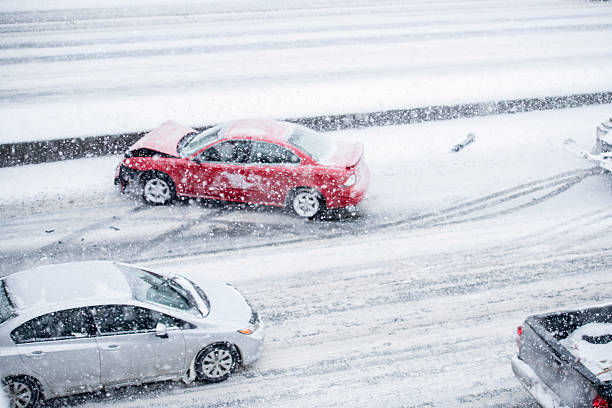Weather-related accidents are a leading cause of injury and property damage on U.S. roadways. According to the Federal Highway Administration, approximately 21% of all vehicle crashes are related to adverse weather conditions, resulting in over 5,000 fatalities and nearly 500,000 injuries each year. While inclement weather presents unavoidable hazards, understanding how liability and causation are determined in these accidents is crucial for protecting your rights and knowing when legal action may be warranted.
Texas, known for its vast highways and diverse climate, faces significant challenges when it comes to weather-related traffic accidents. From severe thunderstorms and flash floods to icy roads in the northern regions, varying weather conditions create unique hazards for drivers and pedestrians alike. In 2024, weather-related accident fatalities continued to be a concern across the state, underscoring the need for increased awareness, better infrastructure, and proactive safety measures.
Key Statistics and Trends
Preliminary reports from the Texas Department of Transportation (TxDOT) reveal concerning statistics for weather-related traffic fatalities in 2024:
- Rain and Wet Roads: The leading cause of weather-related accidents in Texas remains rain and slick pavement. Over 40% of weather-related crashes occurred during rainy conditions, contributing to a significant number of fatalities.
- Fog and Reduced Visibility: Dense fog, particularly in early morning hours, led to multiple chain-reaction collisions, causing several high-profile fatalities on major highways, including I-10 and I-35.
- Flooded Roads: Texas’s notorious flash floods claimed lives again this year. Despite numerous warnings about the dangers of driving through floodwaters, several fatalities resulted from vehicles being swept away.
- Ice and Snow in Northern Texas: Winter storms in January caused hazardous road conditions. In Amarillo and surrounding areas, freezing rain and black ice led to deadly multi-car pileups.
Liability in Weather-Related Accidents
In personal injury law, liability hinges on negligence — the failure to exercise reasonable care under the circumstances. Weather may be a contributing factor in accidents, but it does not absolve drivers of responsibility. Drivers are expected to adjust their behavior to suit weather conditions, and failing to do so can make them liable for accidents.
Examples of Negligent Driving in Bad Weather
- Speeding on Wet or Icy Roads: Drivers must reduce speed to maintain control on slick surfaces.
- Tailgating: Following too closely in rain or snow increases the risk of rear-end collisions.
- Failure to Use Headlights or Wipers: Poor visibility demands that drivers use appropriate tools to see and be seen.
- Improper Lane Changes: Quick maneuvers on slippery roads can lead to loss of control.
If a driver’s negligence contributes to an accident, injured parties may seek compensation for medical expenses, lost wages, pain and suffering, and other damages.
Special Considerations for Commercial Vehicles
Commercial drivers, such as truck operators, have additional obligations under federal and state regulations to ensure safety in adverse conditions. Failure to comply with these standards, such as not using tire chains or ignoring mandatory rest periods, can significantly strengthen a personal injury claim.
Causation in Weather-Related Accidents
Proving causation — the link between the negligent act and the injury — is critical to any personal injury case. In weather-related crashes, this can be complex. Insurance companies often argue that weather, not driver behavior, caused the accident.
To establish causation, a skilled personal injury attorney may:
- Analyze Police Reports: These often include driver behavior and road conditions observations.
- Secure Witness Testimony: Eyewitnesses can corroborate unsafe actions like speeding or improper braking.
- Review Surveillance Footage: Nearby cameras may capture critical moments leading up to the crash.
- Utilize Expert Testimony: Accident reconstruction experts can demonstrate how negligence contributed to the incident.
Liability for Pedestrian Injuries
Pedestrians are also vulnerable in weather-related accidents, and determining liability follows similar negligence principles. Drivers must exercise heightened caution when visibility is reduced or road surfaces are slick. Failing to yield to a pedestrian in a crosswalk, driving too fast for conditions, or not using headlights can result in liability if an accident occurs.
Conversely, pedestrians must act reasonably, such as using designated crosswalks and avoiding sudden, unpredictable movements in traffic. Shared responsibility does not bar recovery of damages; under comparative negligence rules in many states, the fault is apportioned, and compensation is adjusted accordingly.
Premises Liability and Weather Hazards
Slip-and-fall accidents in parking lots or sidewalks also increase during bad weather. Property owners and businesses have a legal obligation to keep walkways reasonably safe.
- Liability may arise if a property owner:
- Fails to clear snow or ice within a reasonable time
- Does not provide adequate warning signs about slippery surfaces
- Allows water to accumulate indoors without proper drainage or mats
If a person is injured due to dangerous conditions, an experienced attorney can help determine whether the property owner’s negligence was a contributing factor.
Preventive Measures to Minimize Legal and Physical Risk
For drivers, taking these steps reduces the risk of accidents and potential liability:
- Adjust speed according to weather and road conditions.
- Maintain proper tire pressure and tread depth for better traction.
- Keep windshield wipers and lights in good condition for improved visibility.
For pedestrians, safety tips include:
- Wearing reflective clothing during rain or low visibility
- Avoiding distractions like phones or headphones when crossing streets.
For property owners, preventive maintenance includes:
- Promptly removing snow and ice from sidewalks and entrances.
- Placing warning signs in areas prone to wet floors.
Conclusion
Weather-related vehicle and pedestrian accidents highlight the delicate balance between natural hazards and human responsibility. While bad weather may contribute to accidents, drivers, pedestrians, and property owners all have duties to act reasonably and take precautions. When these obligations are breached, personal injury law provides a framework for pursuing justice and compensation.
If you have been injured in a weather-related accident, consulting with our personal injury attorneys can help you navigate complex liability and causation issues, ensuring your rights are protected.
Contact PMR Law
If you have been injured in a weather-related car accident, get in touch with us so we can evaluate your case for free. Call PMR Law at 832-626-3879 and a member of our team will get in touch with you immediately.
PMR Law is considered one of the Best Law Firms in America, by Rue Ratings. Several of our attorneys have been given the honor of being named Super Lawyers by Thomson Reuters. The American Institute of Personal Injury Attorneys has named our attorneys 10 Best in Client Satisfaction. Speaking of personal injury, Attorney and Practice Magazine awarded our attorneys with Top 10 Personal Injury Attorney distinctions. The National Trial Lawyers have named three of our attorneys as Top 100 attorneys. The Academy of Attorneys has named two of our attorneys as Top 40 Under 40. Our attorneys have been recognized as Best Attorneys of America, by Rue Ratings. PMR Law is a proud member of the Multi-Million Dollar Advocate Forum. Houstonia Magazine has named two of our attorneys as Top Lawyers in Personal Injury. Forbes Advisor has recognized PMR Law attorneys in their Best Truck Accident Lawyers of Houston. Texas Lawyer magazine has named PMR Law as the #1 Personal Injury Law Firm in Houston.

